The Mysteries of Monna Lisa: A Journey Through Time and Perception
The Mysteries of Monna Lisa: A Journey Through Time and Perception
In the vast tapestry of art history, few pieces evoke as much intrigue, fascination, and contemplation as Leonardo da Vinci's masterpiece, the Mona Lisa, or as it is known in Italian, "La Gioconda." For centuries, this enigmatic portrait has mesmerized audiences with its elusive smile, captivating gaze, and exquisite technique. Join me on an immersive journey as we delve deep into the captivating world of the Mona Lisa, exploring its history, symbolism, and enduring legacy.
1. The Origin Story !
Painted between 1503 and 1506, the Mona Lisa is believed to represent Lisa Gherardini, the wife of Florentine merchant Francesco del Giocondo. Commissioned as a portrait, the painting transcended its original purpose, becoming a timeless symbol of beauty, mystery, and artistic mastery. Leonardo da Vinci's meticulous attention to detail, innovative techniques, and profound understanding of human anatomy imbued the Mona Lisa with a lifelike quality that continues to mesmerize viewers to this day.
2. Mysteries of Monna Lisa Smile
1.1 Decoding the Enigma: The Mona Lisa's Smile
At the heart of the Mona Lisa's allure lies her enigmatic smile, a subject of endless speculation and interpretation. Is she smiling? Is she smirking? The ambiguity of her expression has sparked countless debates and inspired a myriad of theories. Some scholars suggest that the smile is a reflection of the sitter's inner thoughts or emotions, while others propose that it is a deliberate artistic device employed by da Vinci to engage the viewer and evoke a sense of curiosity and intrigue. Regardless of interpretation, the Mona Lisa's smile remains one of the most iconic and enduring images in the history of art.
1.2 The Technique Behind the Beauty
Beyond its subject and expression, the Mona Lisa is a testament to Leonardo da Vinci's unparalleled technical skill and innovation. From the delicate blending of colors to the subtle play of light and shadow, every brushstroke reveals da Vinci's mastery of his craft. One of the most distinctive aspects of the painting is its use of sfumato, a technique characterized by soft, gradual transitions between colors and tones. This technique imbues the painting with a sense of depth and realism, creating an ethereal quality that seems to transcend the boundaries of the canvas.
1.3 Unraveling the Symbolism
Like many great works of art, the Mona Lisa is rich in symbolism and allegory. From the serene landscape in the background to the intricate details of the sitter's clothing and jewelry, every element of the painting holds significance and meaning. Some scholars have suggested that the landscape represents the harmonious relationship between humanity and nature, while others interpret the sitter's attire as a symbol of wealth and status. The enigmatic quality of the Mona Lisa invites viewers to interpret and interpret, inviting them to uncover new layers of meaning with each viewing.
1.4The Legacy of the Mona Lisa
In the centuries since its creation, the Mona Lisa has transcended its status as a mere painting to become a cultural icon of unparalleled significance. Its image has been reproduced, parodied, and immortalized in countless forms, from advertisements to cartoons to memes. The painting's enduring popularity has inspired generations of artists, writers, and thinkers, who continue to explore its themes and symbolism in their work. Moreover, the Mona Lisa's legacy extends beyond the realm of art, influencing fields as diverse as psychology, philosophy, and popular culture.
Conclusion: A Timeless Masterpiece
In conclusion, the Mona Lisa remains as captivating and enigmatic today as it was when Leonardo da Vinci first put brush to canvas over 500 years ago. Its enduring appeal lies not only in its technical brilliance and aesthetic beauty but also in its ability to provoke though.

Comments
Post a Comment